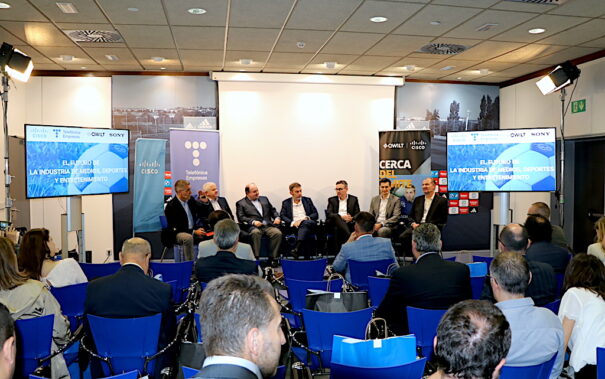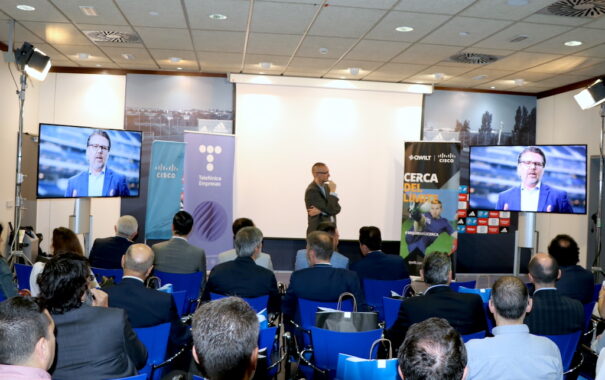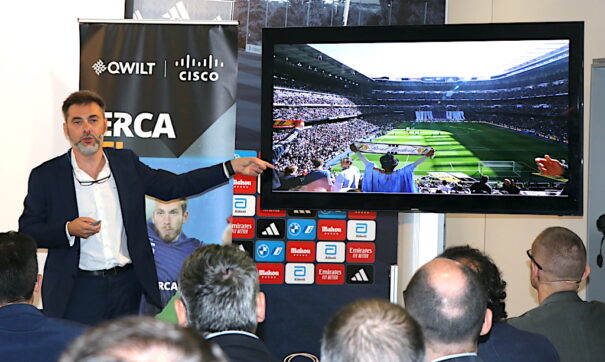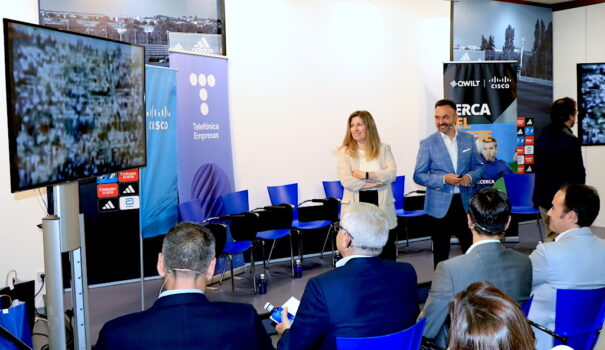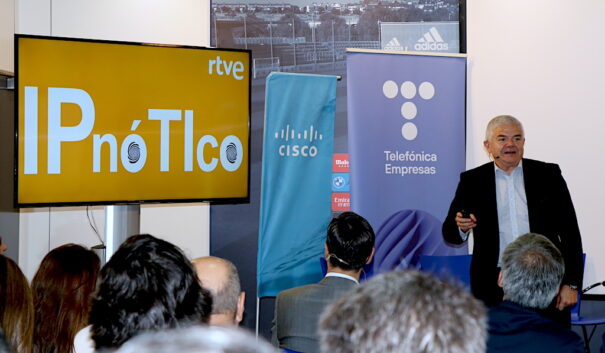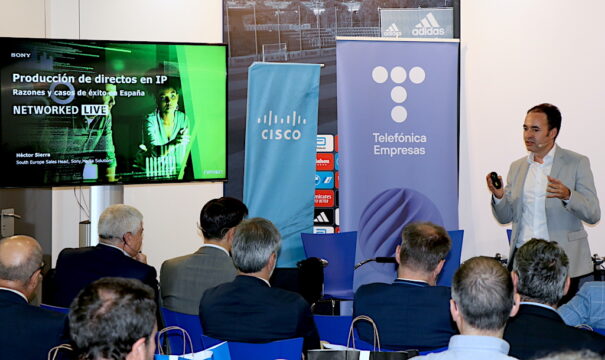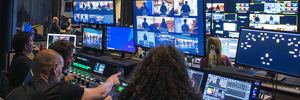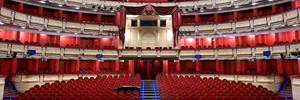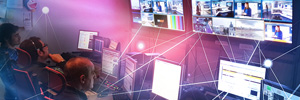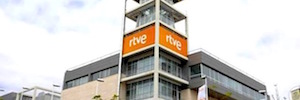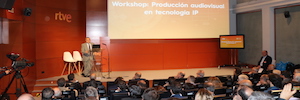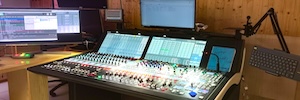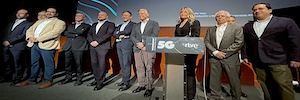El IP marcará el futuro en media, deportes y entretenimiento
La Ciudad Deportiva del Real Madrid en Valdebebas acoge la jornada ‘El futuro de la industria de medios, deportes y entretenimiento’, dado el patrocinio existente entre Culm and the Real Madrid, en la que referentes del sector como la propia Cisco, Telefónica Empresas, Qwilt and Sony han compartido experiencias innovadoras y retos de futuro.
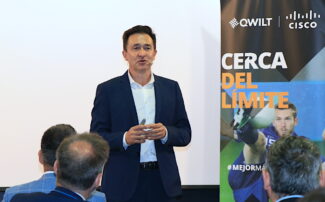 Andreu Vilamitjana, director general de Cisco España, ha sido el encargado de dar la bienvenida al medio centenar de profesionales invitados a esta jornada celebrada 7 de junio. En su intervención ha destacado el potencial del IP para la interconexión de sedes y equipos y ha recordado que el 80% del tráfico de Internet pasa actualmente por equipos Cisco.
Andreu Vilamitjana, director general de Cisco España, ha sido el encargado de dar la bienvenida al medio centenar de profesionales invitados a esta jornada celebrada 7 de junio. En su intervención ha destacado el potencial del IP para la interconexión de sedes y equipos y ha recordado que el 80% del tráfico de Internet pasa actualmente por equipos Cisco.
“Están pasando muchas cosas tanto en la generación de ingresos nuevos por los clubes como a la hora de lograr una experiencia para los aficionados más sencilla, intuitiva e inmersiva”, ha señalado. Además, ha agradecido al Real Madrid y a RTVE que hayan confiado en Cisco para desarrollar sus proyectos de Estadio Infinito y la evolución al IP en el Centro de Producción de Sant Cugat (Barcelona).
También ha señalado que la inversión en tecnologías punteras será capaz de generar flujos de caja que justifiquen el apoyo de los accionistas. “Tenemos una gran oportunidad, en un país maravilloso lleno de gente innovadora y emprendedora, y contamos con la tecnología adecuada para que no sea un gasto sino una inversión”, ha concluido.
Enric Folch, Systems Architect de Cisco, ha compartido su visión sobre la estrategia de Cisco en la industria de media, deporte y grandes acontecimientos. La apuesta, a su juicio, deberá basarse en lograr costes de operación más manejables y que permitan un dinamismo mayor a la hora de entregar contenido de formas muy diferentes, automatizando también los procesos de distribución.
Fidelizar a los fans
Asimismo, fidelizar a los fans permitirá generar más negocio. Las prioridades de los clubes y organizadores de grandes eventos pasan por facilitar que los fans puedan compartir experiencias en redes sociales gracias a la conectividad, personalizar su experiencia y hacerla a la vez más inmersiva.
Folch ha destacado que la tecnología ayudará a que el cliente tenga una experiencia operacional desde que piensa acudir a un evento, compra la entradas o se desplaza a un lugar hasta que disfruta del evento o puede, incluso, comprar un bocadillo sin hacer colas. “En cosas tan mundanas como adquirir comida, la tecnología de Cisco puede ayudar a contar personas en las colas de los diferentes puestos, o distribuir flujos de gente mediante el uso de la cartelería digital”, ha comentado.
Sin duda, “Media Entertainment es el vertical que más está cambiado en cuanto a producción, distribución y consumo”, ha subrayado. Pero este cambio debe ir acompañado de la sostenibilidad, en cuanto a consumo y eficiencia.
La propuesta de Cisco en esta área pasa por dotar a los estadios y otros recintos de una red específica de media, un data center securizado on-premise o en la nube, la orquestación entre diferentes áreas y servicios y un digital signage capaz de transformar un estadio en un espacio polivalente que pueda emplearse para multitud de eventos con la correspondiente monetización.
Enric Folch se ha detenido en mostrar algunos casos de uso como una cartelería digital que aporta flexibilidad en patrocinios personalizados en diferentes puntos de un recinto; la digitalización del recinto con sensores, cámaras, micros… logrando así una representación virtual del recinto; el desarrollo de eventos virtuales paralelos a los físicos y el despliegue de redes digitales y de media. “La producción tradicional SDI está pasando ahora a una red IP. No vale una switch cualquiera ya que no podemos perder paquetes debido a flujos de más de 10 Gbps con protocolos específicos de sincronización de tiempos”, ha afirmado.
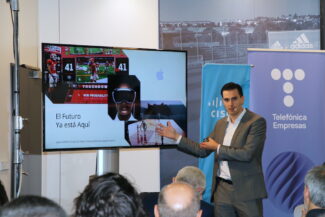 Al hilo de la necesidad de contar con mayores anchos de banda, Alberto Anaya, vicepresidente de ventas del grupo californiano Qwilt, ha abordado los retos que supone el futuro del streaming en directo iniciando su intervención asegurando que “no hay suficiente capacidad para que todo el mundo consuma video en directo solo online y hace falta una solución para que los medios futuros sean consumidos con gafas o desde el móvil. No existe en el mundo capacidad de Internet para que podamos ver todo el contenido online simultáneamente. Por ejemplo, Dazn se encontró con este problema muy de frente a la hora de comenzar a retransmitir fútbol solo online en Italia”.
Al hilo de la necesidad de contar con mayores anchos de banda, Alberto Anaya, vicepresidente de ventas del grupo californiano Qwilt, ha abordado los retos que supone el futuro del streaming en directo iniciando su intervención asegurando que “no hay suficiente capacidad para que todo el mundo consuma video en directo solo online y hace falta una solución para que los medios futuros sean consumidos con gafas o desde el móvil. No existe en el mundo capacidad de Internet para que podamos ver todo el contenido online simultáneamente. Por ejemplo, Dazn se encontró con este problema muy de frente a la hora de comenzar a retransmitir fútbol solo online en Italia”.
La propuesta que Qwilt ofrece junto a Cisco es un CDN cerca del límite. “El 20% de los usuarios de plataformas OTT experimentan Baja Calidad de Experiencia (QoE). Las principales causas son la capacidad de los CDNs en ISPs, su distribución geográfica o una combinación de ambas. La alianza de Qwilt con Cisco y Telefónica pretende redefinir las redes de distribución de contenidos desplegando nodos de distribución de contenidos dentro de las redes del operador sin cuellos de botella, con control completo de QoE y colaborando con los proveedores de contenidos (CSPs)”, ha señalado.
“Dar una experiencia y calidad local con un servicio global, distribuyendo cerca de los usuarios finales es nuestro objetivo. Para ello contamos con más de 800 nodos de acceso repartidos en todo el mundo”, ha subrayado Anaya.
Cabe destacar que la tecnología de Qwilt podemos encontrarla en operadores de primer nivel como Telefónica. “De hecho, el CDN de Movistar Plus+ es ahora más potente gracias a Qwilt”, ha afirmado.
El estadio infinito
Una de las conferencias más esperadas en la jornada El futuro de la industria de medios, deportes y entretenimiento has been carried out by Enrique Uriel, CIO del Real Madrid, abordando cómo el nuevo Estadio Santiago Bernabéu tecnológicamente va ser un estadio infinito.
“Más allá de un estadio de élite, nuestro objetivo es promover una nueva experiencia combinando un dónde, nuestro recinto; el quién, hacia quién voy dirigido, los clientes/fans; y el cómo, la tecnología como habilitador”, ha subrayado.
El Bernabéu históricamente ha sido pionero en implantar nuevas tecnologías tales como el despliegue de redes convergentes, red wifi de alta densidad, redes digitales de emergencia (TETRA), primer centro de control de personas e instalaciones, repeticiones instantáneas, publicidad perimetral personalizada según regiones del mundo… Ahora, el Real Madrid pretende cambiar el concepto de estadio con una propuesta innovadora sostenible, completamente integrada en la ciudad y donde ocurran cosas a diario que atraigan a los fan/clientes de todo el mundo a disfrutar del estadio.
En este sentido, la tecnología pretende ser el “glue” entre el estadio físico y las personas y poder así desarrollar las actividades y eventos que se pretenden.
But las exigencias de los clientes han cambiado, ahora demandan nuevos servicios, interactuar y participar en una experiencia. “Con la mirada puesta en el fan digital, que hoy en día consume Real Madrid en OTT´s, aplicaciones móviles, e-commerce, social media… pretendemos customizar lo que pasará en el estadio a lo que el fan quiere. Para ello, estamos creando un estadio inteligente con la tecnología en su corazón que facilite el desarrollo de nuevos modelos que se aborden desde las áreas de negocio”, ha señalado.
Y es que, según Uriel, el Santiago Bernabéu dará un salto importante en lo que a los smart venue se refiere y es que se pretende sea una referencia en lo que a automation y el uso de IoT se refiere, donde todos los elementos se encuentren intercomunicados a través de la red, volcando información clave para un mantenimiento eficiente y predictivo basado en el análisis inteligente de los datos, y siendo capaces de desencadenar eventos automáticos. Se pasa de un enfoque reactivo a uno proactivo.
En cuanto al modelo broadcast, el nuevo estadio del Real Madrid recuperará para el ciudadano el espacio alrededor del mismo, desplazando todas las unidades móviles a parkings subterráneos específicamente dotados para la realización de TV. Real Madrid apostará por una producción más sostenible y con menos presencia de camiones ofreciendo instalaciones alimentadas con energía verde 100%, salas de producción para unilaterales y una conectividad total para realizar las diferentes retransmisiones. Se apuesta claramente por el uso a medio plazo del cloud como plataforma para la producción de TV. “Ya hemos hecho pruebas de retransmisión de un partido realizado completamente en cloud, una latencia de menos de 1,5 segundos en la entrega de la señal realizada”, ha comentado.
Desde el punto de vista de la experiencia visual en el estadio, se cuenta con más de 5.500 m² de pantallas LED, un zócalo también LED hacia el exterior, cientos de pantallas IPTV y una fachada dinámica permitirán ofrecer a los visitantes una gran cantidad y variedad de contenidos que se esperan producir y distribuir desde una nueva factoría digital desarrollada totalmente en cloud.
Además, el estadio cuenta con un control de realización propio UHD 100% IP (SMPTE 2110), desde el que crear su propio show para las diferentes actividades y eventos a desarrollar en el estadio.
Para llegar a poder prestar todos estos servicios se han desarrollado más de 40 proyectos donde además de la componente tecnológica de los mismos, y dada la hiper-conexión de todo, se ha tenido especialmente en cuenta un factor crítico como es la ciberseguridad. Para ello, el Real Madrid ya implantado un minucioso proceso de homologación de sistemas bajo la batuta de Deloitte, quien realizará además una monitorización 24×7 toda la instalación y cuyo equipamiento y sistemas estarán incluso sometidos a ataques “red team” para detectar vulnerabilidades y poder garantizar un uso sin riesgos de toda la instalación.
Telefónica lidera la transformación
Kepa Aurre, gerente sector de media; Santiago Tripero, gerente del vertical de Deportes y Noemí Pérez, jefa de producto TSA en Telefónica han compartido su experiencia en el desarrollo tecnológico ligado a los medios audiovisuales y a los estadios.
“Los medios y los clubs son fundamentales para el desarrollo tecnológico en el mundo audiovisual. Telefónica está liderando la transformación, con equipos especialistas capaces de aportar una solución completa que aglutine diferentes tecnologías”, ha afirmado Aurre.
Noemí Pérez ha destacado que además de la realización con el uso de nuevos medios como el uso de Spidercam o SlowMotion y la producción remota frente al desplazamiento insitu de unidades móviles o el paso del SD al 4K IP, “la principal evolución frente a las emisiones deportivas del siglo pasado, la encontramos en el estadio y en torno a la experiencia alrededor del partido con pequeños sets y platós, realidad mixta y virtual y aumentada, o el consumo de contenidos mucho más interactivo e inmersivo, entre otros. El fan, pasa del ser mero espectador a ser ahora el gran protagonista”.
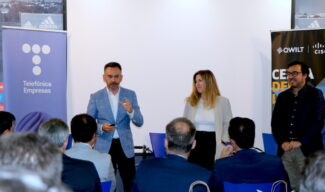 Santi Tripero ha reconocido que “un partido es una experiencia que se vive más allá de 90 minutos amplificándose fuera de los límites del rectángulo de juego. El fan acude al estadio para vivir una experiencia antes, durante y después del partido”. Antes del partido, destacan aspectos como la seguridad, durante el partido la posibilidad de contar la experiencia en tiempo real en redes sociales o disfrutar de espectáculos de luz, sonido o vídeo y una vez concluido el evento, continuar la diversión con museos temáticos, restaurantes, tiendas… Para que todos estos aspectos fluyan es necesario una conectividad que habilite todo lo que va a ocurrir.
Santi Tripero ha reconocido que “un partido es una experiencia que se vive más allá de 90 minutos amplificándose fuera de los límites del rectángulo de juego. El fan acude al estadio para vivir una experiencia antes, durante y después del partido”. Antes del partido, destacan aspectos como la seguridad, durante el partido la posibilidad de contar la experiencia en tiempo real en redes sociales o disfrutar de espectáculos de luz, sonido o vídeo y una vez concluido el evento, continuar la diversión con museos temáticos, restaurantes, tiendas… Para que todos estos aspectos fluyan es necesario una conectividad que habilite todo lo que va a ocurrir.
Pérez considera que las tecnologías y los medios construyen una nueva realidad. “Desde TSA vemos algunas tendencias como el IP transformando el esquema del broadcast; la adopción del 5G; un IP wireless que abra nuevas posibilidades; mayores resoluciones de imagen mirando hacia el 8K o 12K; el paso del CAPEX al OPEX; el uso de infraestructuras onsite junto a la nube; una mayor relevancia de la seguridad y ciberseguridad e inteligencia artificial entendida como automatismos que abren posibilidades inimaginables en cuanto a realización automática, búsqueda semántica de imágenes basada en vectores, doblaje automático generando automáticamente la locución del vídeo a otros idiomas…”.
IPnóTIco Migración IP en RTVE
Jesús García, director del Área Técnica de Spanish Television, ha expuesto los retos que ha supuesto para la Corporación la migración a IP del Centro de Sant Cugat en Barcelona (estudios 1,2, 3 y 4, grafismo y grabación) llevada a cabo por los ingenieros de RTVE, junto a los profesionales de Cisco, Telefónica y otros proveedores.
Tanto el área de informativos como de programas cuentan ya con todo el equipamiento técnico 100% conectados en IP con una red basada en ST2110, sincronización PTP-NET y una red de control VSM (Lawo). García ha afirmado que en esta nueva instalación se hace imprescindible contar con un monitorado del estado de la red y análisis para todos los flujos de señales.
En un futuro próximo, RTVE renovará toda la continuidad apagando el SDI y pasando a un full IP migrando la redacción digital a IP 2110. En un último paso, migrará a IP los estudios 5 y 6.
García se ha detenido en cuestiones como la necesidad de contar con equipamiento con interoperabilidad acreditada, evitar soluciones híbridas SDI-IP, contar con una arquitectura de red y direccionamiento escalable a futuro, mantener una línea de diseño maestro sin excepciones, trabajar en la adaptabilidad y workarounds colaborativos entre fabricantes, disponer de interfaces software sencillos y herramientas de red sencillas que permitan analizar qué está pasando. También ha querido detenerse en el perfil técnico de los profesionales en estos nuevos entornos, contando con nuevos perfiles especializados en IP.
Un aspecto a destacar del IP es la posibilidad de Remote Production. Actualmente, RTVE retransmisiones está poniendo en marcha experiencias de producción sobre IP desde el Teatro Monumental (sede la Orquesta RTVE), el edifico de La Bolsa, el salón de Loterías y Apuestas del Estado o el edificio de la Corporación en Carrer Roc Boronat en el centro de Barcelona.
García también ha compartido su experiencia en contribuciones IP sobre redes 4G y 5G. En las últimas elecciones el pasado 28M, RTVE empleó en contribución más de un centenar de mochilas logrando así inmediatez en el punto de noticia, órdenes talk-back integradas en la red intercom, retorno de programa en smartphone y envíos FTP…
Por último, ha hecho hincapié en que trabajar en un entorno TI permite la adaptabilidad de los recursos, el aislamiento entre sistemas, la escalabilidad de la infraestructura, la facilidad en la actualización de aplicaciones y OS y la clonación y restauración de sistemas.
“Tras las experiencias vividas, consigues quedarte un poco IPnoTIzado (en este caso sin h) con las prestaciones que IP y tecnologías de la información han aportado a la producción en el mundo broadcast”, ha señalado.
Producción en directo en IP
El director de ventas del sur de Europa de Sony, Héctor Sierra, ha iniciado su intervención asegurando que “el IP permite producir más y de manera más eficiente compartiendo y distribuyendo recursos; disponer de mayor flexibilidad y escalabilidad absorbiendo necesidades puntuales elásticamente; mejorar la sostenibilidad de la producción con menos desplazamientos y logísticas más sencillas; y asegurar la vigencia tecnológica en base a disponibilidad presupuestaria no recurrente”.
Sierra ha repasado algunos de los últimos casos de éxito en los que la tecnología de Sony ha ayudado a migrar en un entorno IP. En el caso de Warner Bros Discovery, para sus canales Eurosport ha conectado mediante 2110 sus dos centros de producción en Reino Unido y Holanda con otras delegaciones compartiendo diferentes recursos y dotándose de un pool de recursos compartidos a través de la red. En este caso se emplea una capa de orquestación y gestión SDN mediante VideoIpath de Nevion y compresión a través de Virtuoso Nevion, lo que redunda en una mayor flexibilidad en la producción, un mejor uso de los recursos y una reducción de los costes de ancho de banda.
En España, encontramos proyectos tan relevantes como Telemadrid, TV3 o RTPA Asturias. En el caso de la autonómica madrileña, se han renovado sus estudios de producción en un proyecto liderado por TSA en el que se han integrado cámaras Sony HDC-3100, mezcladores de vídeo XVS-7000 y monitores LMD-A. La red desplegada es de Cisco, con sistemas de control y procesamiento de Lawo.
Gracias a este proyecto, Telemadrid cuenta ahora con dos controles que dan servicio a cuatros platós ganando en eficiencia, preparados para producción remota, gestión y flujos de trabajo más sencillos y una mejor calidad para la audiencia.
With regard to the Corporació Catalana de Mitjans Audiovisuals, la CCMA ha renovado el estudio de su telenoticias 3/24 implantando un proyecto 100% IP. En este caso, se ha optado por el sistema Nevion VideoIpath como gestor global, compatible con el resto de fabricantes, cámaras HDC 3100 en configuración con IP Box (es decir sin CCU) y monitores PVM-X de Sony.
La televisión del Principado de Asturias RTPA ha homogeneizado el IP tanto en estudios de televisión, radio, continuidad y control central. TSA ha integrado en este caso cámaras HDC-3200, HDC-P50 (tipo caja) y PTZs robotizadas de Sony junto a mezcladores de vídeo XVS-7000/6000. Todo ello bajo una red Cisco con control y procesamiento de Lawo.
Por último, Héctor Sierra se ha detenido en el proyecto del Estadio Santiago Bernabéu. En este caso, el Real Madrid ha contado con la complicidad de Sony desde su sede central en Japón, poniendo a prueba, incluso, equipamiento no disponible comercialmente por el momento. En su nuevo estudio de producción, el club empleará una solución con cámaras HDC-3500/3200 en configuración IP Box (solo IP) y FR7 robotizadas.
Sierra ha concluido su ponencia afirmando que “el IP ST-2110 ha alcanzado la madurez tecnológica, contando ahora con equipamiento probado y verificado”.
La Jornada El futuro de la industria de medios, deportes y entretenimiento ha concluido con una Round table moderada por el periodista Javier Reyero en la que además de algunos de los ponentes de la mañana se han sumado José Pérez, Solutions Arquitect en Cisco; Adolfo Muñoz, director del área de emisiones de RTVE; y José Luis García Cabrera, director de servicios audiovisuales y plataformas en TSA.
Pérez ha reconocido que “a medida que vamos a contenidos de más calidad, necesitaremos más ancho de banda local. Tanto para producción remota como para distribución final de contenidos, necesitaremos más ancho de banda. Esto supone una mayor complejidad en procesamiento, computación e inteligencia”.
Por su parte, García Cabrera admite que “veo el futuro híbrido. Vivimos un momento de transición, la tecnología es un habilitador increíble pero encontramos situaciones donde todavía estamos ante determinados eventos que nos cuesta delegar al 100% en el IP”. Además ha insistido en la “importancia de la ciberseguridad en la ‘IPerización’ de todas las operaciones”.
Por último, Adolfo Muñoz, ha centrado su intervención en que la sociedad demanda más calidad y cantidad de contenido. “El espectador no se conforma ya con ver la retransmisión de un partido en un Roland Garros, por ejemplo, lo que quiere es elegir qué partido quiere ver y seguir a un tenista determinado accediendo a contenidos más allá de la señal de programa”.
Did you like this article?
Subscribe to our NEWSLETTER and you won't miss a thing.
•Section: Emission, I am a student, IP, Television, TV Corporate, TV Production



